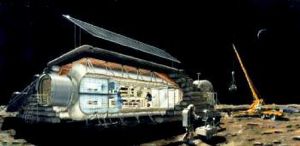
Home - Search - Browse - Alphabetic Index: 0- 1- 2- 3- 4- 5- 6- 7- 8- 9
A- B- C- D- E- F- G- H- I- J- K- L- M- N- O- P- Q- R- S- T- U- V- W- X- Y- Z
Outpost on the Moon
Status: Study 1987.
The Ride Report was issued in August 1987, and proposed establishment of an Outpost on the Moon using Shuttle and Space Station hardware that was expected to be already available by the late 1990's. The Ride Report would be fleshed out by NASA in the 90-day study's Lunar Outpost two years later.
The Ride Report proposed a gradual, three-phase evolution of ability to live and work on the lunar surface.
Phase I: Search for a Site (1990s)
The initial phase would focus on robotic exploration of the Moon. It would begin with the launching of the Lunar Geoscience Observer, which would map the surface, perform geochemical studies, and search for water at the poles. Depending on the discoveries of the Observer, robotic landers and rovers could be sent to the surface to obtain more information. Mapping and remote sensing would characterize the lunar surface and identify appropriate sites for the outpost. The discovery of water or other volatiles would be extremely significant, and would have important implications for the location of a habitable outpost.
Phase II: Return to the Moon (2000-2005)
Phase II would begin with the return of astronauts to the lunar surface. The initiative proposed that a crew be transported from the Space Station to lunar orbit in a module propelled by a lunar transfer vehicle. The crew and equipment would land in vehicles derived from the transfer vehicle. Crew members would stay on the surface for one to two weeks, setting up scientific instruments, a lunar oxygen pilot plant, and the modules and equipment necessary to begin building a habitable outpost. The crew would return to the orbiting transfer vehicle for transportation back to the Space Station.
Over the first few flights, the early outpost would grow to include a habitation area, a research facility, a rover, some small machinery to move lunar soil, and a pilot plant to demonstrate the extraction of lunar oxygen. By 2001, a crew could stay the entire lunar night (14 Earth days), and by 2005.the outpost would support five people for several weeks at a time.
Phase III: At Home on the Moon (2005-2010)
Phase III evolved directly from Phase II, as scientific and technological capabilities allow the outpost to expand to a permanently occupied base. The base would have closed-loop life-support systems and an operational lunar oxygen plant, and would be involved in frontline scientific research and technology development. The program also requires the mobilization of disciplines not previously required in the space program: surface construction and transportation, mining, and materials processing.
By 2010, up to 30 people would be productively living and working on the lunar surface for months at a time. Lunar oxygen would be available for use at the outpost and possibly for propellant for further exploration.
Family: Lunar Bases, Moon. Country: USA. Agency: NASA.
Back to top of page
Home - Search - Browse - Alphabetic Index: 0- 1- 2- 3- 4- 5- 6- 7- 8- 9
A- B- C- D- E- F- G- H- I- J- K- L- M- N- O- P- Q- R- S- T- U- V- W- X- Y- Z
© 1997-2019 Mark Wade - Contact
© / Conditions for Use
